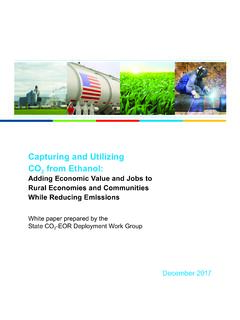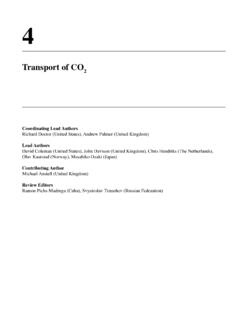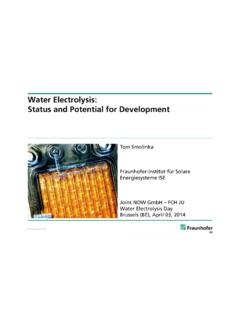Transcription of The cover photo of the Office of Fossil Energy and Carbon
1 The cover photo of the Office of Fossil Energy and Carbon Management's (FECM) Strategic Vision portrays a puzzle in progress. FECM priorities are represented as puzzle pieces of a larger portfolio of approaches that will be collectively required to achieve net-zero greenhouse gas emissions by mid-century. The striped backdrop illustrates observed warming global temperature trends with a stylized reversal evoking the long-term potential to slow, then possibly reverse warming as we reach zero, and eventually negative emissions. cover Image Credits: Ed Hawkins, National Centre for Atmospheric Science, University of Reading. STRATEGIC VISION SUMMARY. With Executive Order 14008, Tackling the Climate Crisis at communities, as well as through stakeholder engagement and a Home and Abroad, President Biden set a goal to lead a clean focus on workforce development. Energy revolution that achieves a Carbon pollution-free power International and Domestic Partnerships: FECM will foster and sector by 2035 and puts the United States on an irreversible leverage connections with international and domestic partners, path to a net-zero economy by 2050 (Federal Register, 2021).
2 Collaborate within DOE and the broader government and The Energy portfolio and economy depend heavily on encourage public-private partnerships to assist in meeting the Fossil fuels and other sources of GHG emissions today, spanning Biden Administration's climate goals. sectors like power generation, industry, heat and transportation fuels. Advancing clean Energy , Carbon capture with durable Advancing Carbon Management storage in both the power and industrial sectors and CDR are Approaches toward Deep imperative for achieving net-zero GHG goals. FECM envisions Decarbonization enabling the demonstration and ultimately deployment of Point-Source Carbon Capture (PSC): FECM will invest in technologies for Carbon management and mitigating challenges RDD&D to reduce the cost, increase the efficacy and advance of Fossil fuel use in a just and sustainable way, with the goal the deployment of commercial-scale PSC technologies in the of achieving net-zero GHG emissions by mid-century.
3 FECM power and industrial sectors, coupled to permanent storage. prioritizes the following three strategic directions and related priorities to achieve these goals: Carbon Dioxide (CO2) Conversion: FECM will accelerate capabilities for large-scale conversion of CO2 into products Advancing Justice, that advance net-zero and justice goals, facilitated by markets Labor and Engagement for CO2 as a feedstock. FECM will help accelerate the path to a net-zero refinery, advance mineral carbonation approaches and Justice: FECM is committed to incorporating justice principles expand the availability of synthetic fuels. throughout our work. FECM prioritizes the meaningful participation of communities, with special focus on Carbon Dioxide Removal (CDR): FECM will invest in a diverse disadvantaged communities; a just distribution of benefits; and set of CDR approaches to support DOE's Carbon Negative Shot emphasis on remediating legacy harms while also mitigating of just, sustainable and scalable CDR at costs below $100/net new impacts.
4 These principles will be at the center of funding metric ton of CO2-equivalent (CO2e). This full suite of CDR. decisions, including implementation of Justice40, and approaches will help address emissions from extremely hard- partnership development. to-decarbonize sectors and eventually address legacy emissions. Near-term focus areas include advancing DAC coupled to Labor: FECM aims to accelerate the growth and preservation durable storage and creating a framework for developing the of good-paying jobs in the production of responsible clean full portfolio of CDR methods. Energy and climate change solutions. FECM will implement, support and expand robust labor engagement in disadvantaged Reliable Carbon Storage and Transport: FECM will establish communities, empowering them to implement place-based the foundation for a successful Carbon transport and storage solutions that address their unique resources and needs. This industry, supporting the transition from Carbon production to work will be done both through newly built programs like storage, by making advancements in storage technologies and the Interagency Working Group on Coal and Power Plant STRATEGIC VISION | i Strategic Vision Summary transport mechanisms, providing technical assistance in industry, especially coupled to remediation of legacy wastes.
5 Class VI well permitting and supporting large-scale transport FECM will support demonstrations for extraction and and storage facilities and regional hubs. remediation to processing and refining for building a strong CM supply chain while creating good-paying jobs. Advancing Technologies that Methane Mitigation: FECM will invest in minimizing the Lead to Sustainable Energy environmental impacts associated with the extraction of Fossil Resources Energy sources produced in the United States, including coal, Hydrogen with Carbon Management: FECM will invest in oil and natural gas, with a specific focus on methane mitigation. RDD&D for hydrogen production coupled with CCS using FECM plans to advance cost-effective technology to efficiently sustainably sourced Carbon -based feedstocks ( , biomass, identify, quantify and predict methane leaks across sectors more Fossil fuels and plastics, including wastes). FECM will invest in efficiently, and improve accessibility and reliability of methane the advancement and utility-scale demonstration of hydrogen emissions data.
6 Supply and utilization technologies like hydrogen storage, reversible solid oxide fuel cells (SOFCs) and 100 percent As we continue to invest in technologies that lead to achieving hydrogen fired turbines, supporting DOE's Hydrogen Shot the Administration's net-zero GHG emissions goals, we will target. be thoughtful and strategic toward prioritizing approaches that minimize environmental and climate impacts from the Domestic CM Production: FECM will help grow an extraction of Fossil fuels and Carbon -based feedstocks to their environmentally and economically sustainable, secure, diverse end use for meeting our Energy needs. and resilient domestic CM and Carbon ore resource recovery ii | STRATEGIC VISION. A MESSAGE FROM THE FECM. LEADERSHIP TEAM. The Office of Fossil Energy and Carbon Management's (FECM) core mission is to address the climate crisis. Addressing climate change is more urgent than ever, and we must do all we can to limit harm to people, communities, the planet and the economy.
7 In partnership with other offices in the Department of Energy (DOE), FECM supports this mission through investments in research, development, demonstration and deployment (RDD&D) of technologies and solutions to ensure clean and affordable Energy , a healthy climate, policy development and stakeholder engagement specifically focused on minimizing the environmental impacts of Fossil fuels and helping the nation achieve net-zero greenhouse gas (GHG) emissions through activities like expanding the reach of Carbon capture and storage (CCS) technologies, advancing Carbon dioxide removal (CDR) technologies, reducing methane emissions from the Fossil fuel supply chain, advancing a clean hydrogen economy and developing domestic sources of the critical minerals (CMs) that will be required in a clean Energy economy. FECM's priority is reaching the Biden Administration's goals of a fully decarbonized power sector by 2035 and net-zero GHG. emissions by 2050 (facilitated by an interim goal of achieving 50-52 percent reductions by 2030 below 2005 levels).
8 This Strategic Vision will enable DOE to make strategic Carbon management decisions and ensure the use of Fossil fuels is put into proper context with climate change and is designed for a future that achieves and maintains net-zero GHG emissions. This document outlines a vision with Energy and environmental justice at the core of FECM's work, as the Office strives to build Energy infrastructure in a just and sustainable way. FECM must constantly reexamine the meaning of success in order to build creative approaches that enable the Office to advance the country toward a net-zero future. DOE supports projects with large, long-lived assets. In some cases, designing investments for the highest possible value and impact may mean that the metrics and choices seem counterintuitive from the perspective of 2022. It is imperative to remember these investment strategies are designed to be maximally successful in 2050 and beyond, not over the next budget cycle.
9 Specifically, searching for and finding ways this work can enable and reinforce broader decarbonization, without creating path dependencies that lock into patterns of the past, is one mission and a major charge of FECM. For FECM, the orientation of investments means focusing on the path to net-zero GHG emissions and also constantly evaluating how these efforts integrate with the systems that will exist in the future. Consider what 2050 will look like after the successful decarbonization transition in the United States, catalyzed by the efforts of FECM, other DOE offices, other agencies and civil society: Electricity is generated from sources that produce effectively no air emissions, like GHGs, and supports total electrification for applicable systems. Homes and other buildings are highly efficient, providing climate resilience and allowing for more flexible demand while accommodating a mature, decarbonized Energy system. CDR is deployed at a scale necessary to account for residual and legacy GHG emissions, especially for those difficult-to-abate sectors like agriculture.
10 FECM's research on CDR, industrial CCS and 100 percent hydrogen-fired turbines has resulted in the maturation and widespread industrial deployment of these technologies. Other research on methane mitigation from Fossil systems, Carbon -based hydrogen production, power sector CCS and remediation-linked recovery of CMs used for clean Energy infrastructure enabled a highly successful decarbonization transition. This research paved the way for new focus areas like residual GHG management from non- Fossil activities, water management, critical mineral recovery from non- Fossil wastes and much more. Access to clean electricity to run flexible direct air capture (DAC) plants for CDR has allowed for CDR to be used on a global scale. Clear policy support for clean products such as cement, concrete and steel has helped drive lower costs, more sustainable materials and new opportunities to achieve negative emissions. Fossil fuels are replaced by low-cost zero- Carbon alternatives, enabling a phase-down and just transition toward a point where a transition of skills and geology formerly devoted to Fossil fuel extraction is now devoted to geothermal and Carbon storage technologies, potentially including biomass with Carbon removal and storage (BiCRS).

















